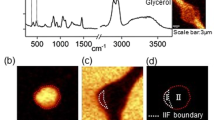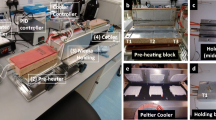Abstract
In this investigation, the macromolecular crowding effect of a carbohydrate-based polymer, pullulan, and a salt-based polymer, poly-(4-styrenesulfonic-acid) sodium salt (PSS) was compared for the storage of A549 lung carcinoma cells, at temperatures greater than that of liquid nitrogen storage tanks. A DoE-CCD response surface model was used to optimise medium compositions comprising DMSO and a macromolecular crowder (MMC; pullulan, PSS and their combinations). The effect of adding MMCs was evaluated in terms of post-preservation viability, apoptotic population and growth curve analysis. The optimised medium consisting of 10% DMSO and 3% pullulan in the basal medium (BM) could facilitate long-term cell preservation for 90 days at − 80 °C, resulting in cell viability of ∼83%. The results also showed a significant decrease in the apoptotic population at all time points for the optimised composition of the freezing medium. These results indicated that adding 3% pullulan to the freezing medium improved the post-thaw viability and reduced the apoptotic cell population.











Similar content being viewed by others
Data Availability Statement
All data generated or analysed during this study are included in this published article and its Supplementary Information files. Any additional data will be made available upon reasonable request.
References
Abreu Costa L, Henrique FernandesOttoni M, Dos Santos MG et al (2017) Dimethyl sulfoxide (DMSO) decreases cell proliferation and TNF-α, IFN-γ, and IL-2 cytokines production in cultures of peripheral blood lymphocytes. Mol Basel Switz 22:E1789. https://doi.org/10.3390/molecules22111789
Alric B, Formosa-Dague C, Dague E et al (2022) Macromolecular crowding limits growth under pressure. Nat Phys 18:411–416
APC Annexin V/Dead Cell Apoptosis Kit with APC annexin V and SYTOX® Green for Flow Cytometry (2010) Invitrogen. https://tools.thermofisher.com/content/sfs/manuals/mp35113.pdf
Bahuguna A, Khan I, Bajpai VK, Kang SC (2017) MTT assay to evaluate the cytotoxic potential of a drug. Bangladesh J Pharmacol 12:8
Best BP (2015) Cryoprotectant toxicity: facts, issues, and questions. Rejuvenation Res 18:422–436
Bhattacharya S (2018) Cryoprotectants and their usage in cryopreservation process. IntechOpen, London
Bulman SE, Coleman CM, Murphy JM et al (2015) Pullulan: a new cytoadhesive for cell-mediated cartilage repair. Stem Cell Res Ther 6:34. https://doi.org/10.1186/s13287-015-0011-7
Burden DW (2020) Issues in contamination & temperature variation in the cryopreservation of animal cells & tissue. Int Biotechnol Lab 20:20–29
Château MT, Ginestier-Verne C, Chiesa J et al (1996) Dimethyl sulfoxide-induced apoptosis in human leukemic U937 cells. Anal Cell Pathol J Eur Soc Anal Cell Pathol 10:75–84
Galicia-Vázquez G, Aloyz R (2018) Ibrutinib resistance is reduced by an inhibitor of fatty acid oxidation in primary CLL lymphocytes. Front Oncol 8:411. https://doi.org/10.3389/fonc.2018.00411
Galvao J, Davis B, Tilley M, Normando E, Duchen MR, Cordeiro MF (2014) Unexpected low-dose toxicity of the universal solvent DMSO. FASEB J 28:1317–1330
Ghasemi M, Turnbull T, Sebastian S, Kempson I (2021) The MTT assay: utility, limitations, pitfalls, and interpretation in bulk and single-cell analysis. Int J Mol Sci 22:12827. https://doi.org/10.3390/ijms222312827
Gironi B, Kahveci Z, McGill B, Lechner BD, Pagliara S, Metz J, Morresi A, Palombo F, Sassi P, Petrov PG (2020) Effect of DMSO on the mechanical and structural properties of model and biological membranes—sciencedirect. Biophys J 119:274–286
Gore M, Narvekar A, Bhagwat A et al (2022) Macromolecular cryoprotectants for the preservation of mammalian cell culture: lessons from crowding, overview and perspectives. J Mater Chem B 10:143–169
Guo MQ, Hu X, Wang C, Ai L (2017) Polysaccharides: structure and solubility. IntechOpen, London
Jiang R, Shen H, Piao Y-J (2010) The morphometrical analysis on the ultrastructure of A549 cells. Romanian J Morphol Embryol Rev Roum Morphol Embryol 51:663–667
Joseph E, Singhvi G (2019) Chapter 4 - Multifunctional nanocrystals for cancer therapy: a potential nanocarrier. In: Grumezescu AM (ed) Nanomaterials for drug delivery and therapy. William Andrew Publishing, pp 91–116
Kelly MA, Zieba AP, Buttemer WA, Hulbert AJ (2013) Effect of temperature on the rate of ageing: an experimental study of the blowfly Calliphora stygia. PLoS ONE 8:e73781. https://doi.org/10.1371/journal.pone.0073781
Mackenzie CG, Mackenzie JB, Beck P (1961) The effect of pH on growth, protein synthesis, and lipid-rich particles of cultured mammalian cells. J Biophys Biochem Cytol 9:141–156
Mazur P (1984) Freezing of living cells: mechanisms and implications. Am J Physiol 247:C125-142. https://doi.org/10.1152/ajpcell.1984.247.3.C125
Melissa CS (2021) Medical Definition of Cryopreservation. In: MedicineNet. https://www.medicinenet.com/cryopreservation/definition.htm. Accessed 26 Jul 2022
Mr Mitra A (2021) Natural Resources & Biodiversity. HSRA, India
Muniyasamy A, Sivaporul G, Gopinath A et al (2020) Process development for the degradation of textile azo dyes (mono-, di-, poly-) by advanced oxidation process—ozonation: experimental & partial derivative modelling approach. J Environ Manag 265:110397. https://doi.org/10.1016/j.jenvman.2020.110397
Narvekar A, Gawali SL, Hassan PA et al (2020) pH dependent aggregation and conformation changes of rituximab using SAXS and its comparison with the standard regulatory approach of biophysical characterisation. Int J Biol Macromol 164:3084–3097. https://doi.org/10.1016/j.ijbiomac.2020.08.148
Naumov AA, Dubrovskii AV, Musin EV et al (2018) A study of the cytotoxic effect of microcapsules and their constituent polymers on macrophages and tumor cells. Bull Exp Biol Med 166:69–74. https://doi.org/10.1007/s10517-018-4291-7
Nishizawa K, Fujiwara K, Ikenaga M et al (2017) Universal glass-forming behavior of in vitro and living cytoplasm. Sci Rep 7:15143. https://doi.org/10.1038/s41598-017-14883-y
Poon C (2022) Measuring the density and viscosity of culture media for optimised computational fluid dynamics analysis of in vitro devices. J Mech Behav Biomed Mater 126:105024. https://doi.org/10.1016/j.jmbbm.2021.105024
Quain M (2020) Cryopreservation—current advances and evaluations. IntechOpen, London
Ren Z-X, Yu H-B, Li J-S et al (2015) Suitable parameter choice on quantitative morphology of A549 cell in epithelial–mesenchymal transition. Biosci Rep 35:e00202. https://doi.org/10.1042/BSR20150070
Saber-Samandari S, Gazi M (2015) Pullulan based porous semi-IPN hydrogel: synthesis, characterisation and its application in the removal of mercury from aqueous solution. J Taiwan Inst Chem Eng 51:143–151. https://doi.org/10.1016/j.jtice.2015.01.013
Strober W (2015) Trypan blue exclusion test of cell viability. Curr Protoc Immunol 111:A3.B.1-A3.B.3. https://doi.org/10.1002/0471142735.ima03bs111
Wingett D, Louka P, Anders CB et al (2016) A role of ZnO nanoparticle electrostatic properties in cancer cell cytotoxicity. Nanotechnol Sci Appl 9:29–45. https://doi.org/10.2147/NSA.S99747
Yawn DH (2020) Cryopreservation, description, techniques, & applications, britannica. https://www.britannica.com/technology/cryopreservation. Accessed 26 Jul 2022
Yuan Y, Yang Y, Tian Y et al (2016) Efficient long-term cryopreservation of pluripotent stem cells at −80 °C. Sci Rep 6:34476. https://doi.org/10.1038/srep34476
Zanoni M, Piccinini F, Arienti C et al (2016) 3D tumor spheroid models for in vitro therapeutic screening: a systematic approach to enhance the biological relevance of data obtained. Sci Rep 6:19103. https://doi.org/10.1038/srep19103
Acknowledgements
The authors are thankful to DBT, GoI for funding aid. The authors are thankful to Gangwal Chemicals for providing Hayushibara's pullulan. The authors are also thankful to Devashree Jahangirdar, Pooja Sawant, Junaid Parkar and other members of the Nano-medicine Research Group, Institute of Chemical Technology, Mumbai, for their timely help in the undertaking of this project.
Author information
Authors and Affiliations
Contributions
AK: performed experiments, conceptualisation and writing—original draft and editing. AB: investigation and writing—review and editing. PDJ: conceptualisation, investigation supervision, project administration and writing—review and editing. RJ: supervision and project administration.
Corresponding authors
Ethics declarations
Conflict of interest
The authors report no declarations of interest.
Ethical approval
No animal or human trials were used for this research.
Supplementary Information
Below is the link to the electronic supplementary material.
Rights and permissions
Springer Nature or its licensor (e.g. a society or other partner) holds exclusive rights to this article under a publishing agreement with the author(s) or other rightsholder(s); author self-archiving of the accepted manuscript version of this article is solely governed by the terms of such publishing agreement and applicable law.
About this article
Cite this article
Kumaran, A., Bhagwat, A., Jain, R. et al. Comparison between carbohydrate and salt-based macromolecular crowders for cell preservation at higher temperatures. 3 Biotech 13, 184 (2023). https://doi.org/10.1007/s13205-023-03571-6
Received:
Accepted:
Published:
DOI: https://doi.org/10.1007/s13205-023-03571-6




